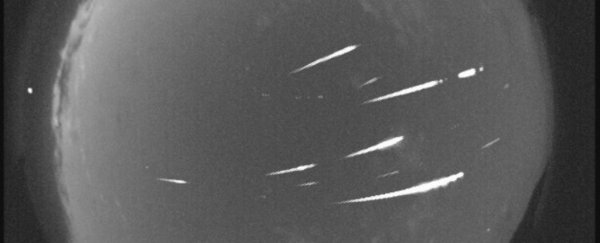For those of you needing to escape the (Australian) budget announcement this week, the cosmos has produced a perfect distraction with the regular and reliable meteor shower, the Eta Aquarids, to give you a reason to look up from the paperwork.
The Eta Aquarids meteor shower is caused by Earth ploughing through the debris tail of the Halley's Comet. These tiny grains of material burn up in the atmosphere as they strike the air at speeds of tens of thousands of kilometres. We feel a similar force when holding our hands out of a moving car. Now imagine doing it a hundred times faster, and you get some idea of why the friction with the air can destroy the grains. The intense heat produced causes the air itself to glow white hot, which we see as the streak of light in the sky.
With no moonlight to outshine these shooting stars, Australians in dark sites may see as many as 60 trails per hour in the early pre-dawn Thursday and Friday morning. This is one for the early birds/night owls. Most meteorites will be visible from 1am to 6am (just before dawn), but in these dark skies you can see the odd random shooting star anytime after sunset (it just won't be part of the more numerous Eta Aquarids meteor shower).
To maximise your chance of seeing the 'radiant' or region from which the meteor showers appear to originate from, look East/North-East. However, if there are bright lights in the way, it's best to just look away into a dark region as the shooting star trails will still be visible across the sky.
No Moon is a Good Moon
Unlike last year's meteor shower when a Full Moon blinded us to all but the brightest shooting stars, this year sees a Super New Moon. This is where the Moon lies between us and the Sun, and as a result the illuminated face can't be seen, making it effectively invisible.
However, the Moon is also 20,000 km closer to Earth than average, and would appear bigger on the sky if it was visible, so this would really have ruined the great meteor shower for us.
As it lies closer to Earth, the tides raised by the Moon will be larger, so this Super New Moon may not be visible to us but the effects are as a Perigean 'Spring' or 'Fall' tide.
 NOAA
NOAA
So take a break from the budget this week and enjoy the spectacular sight of a meteor shower, without the unwelcome glare of ordinarily lovely lunar light.
Alan Duffy, Research Fellow, Swinburne University of Technology.
This article was originally published by The Conversation. Read the original article.
Swinburne University of Technology is a sponsor of ScienceAlert. Find out more about their innovative research.
